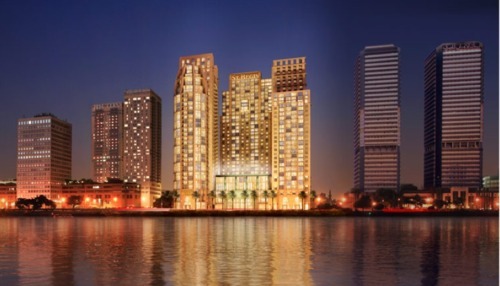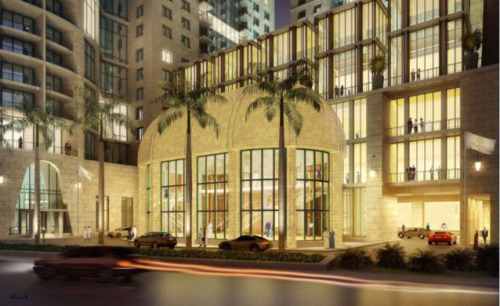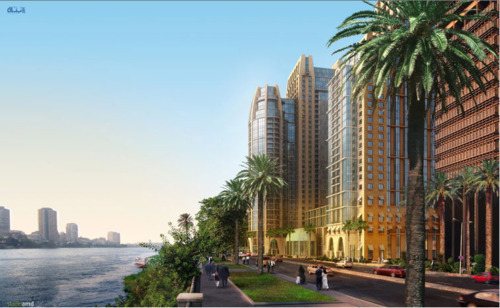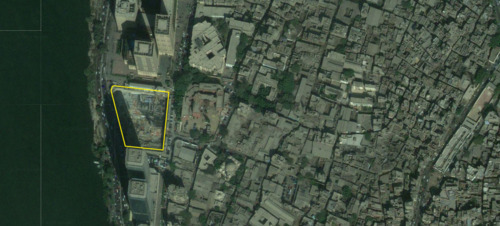New Construction: St. Regis

Actually this construction isn’t so new, it has been slowly trying to make its way out of the ground for a few years now and it will be another few years before it is complete. The 6 billion+ Egyptian pound investment by Qatari Diar is expected to be finished in 2014, however it may take longer with 2016 as a more realistic completion date. The St. Regis project consists of two towers designed by Michael Graves’ firm which already graced Egypt with a few projects in rather exclusive locals, so this will be its most visible. The location is on the Nile between the World Trade Center and Ahli Bank Towers facing Zamalek. The towers also turn their back on Boulac, one of Cairo’s historic districts, which if it were up to investors from the Gulf and their worshipers in the Egyptian businessmen club, that neighborhood would be erased from existance. Shame, because Boulac, like almost any of Cairo’s older districts, is diverse, full of interesting domestic architecture, lively and could provide a fantastic view from the shiny new towers if the district received some attention. But who needs community, who needs history, who needs heritage… who needs Egyptians at all, lets just tear it all down. Oh, yes, we need some Egyptians to work at the hotel, wash dishes, operate lifts and clean rooms, the rest can just go somewhere else so we don’t have to look at their ugly dusty “historic” houses from our fancy sleek glass towers. “From up here those people look like ants.” Modernity has arrived Gulf style.
Since the 1970s when Sadat wanted to open Egypt for uber-capitalist modernization (an oxymoron?) this part of the Nile was envisioned as a facade of modernity with towers rising as trophies advertising Egypt’s realignment with the West. With his naive optimism, Sadat assumed that American-style capitalism would bring bounty to Egypt. Needless to say he was dead wrong. The gap between the rich and the poor has never been so large and Sadat’s policies, continued by Mubarak, only allowed a select group of men and their associates into the VIP club and the rest of Egypt was sidelined, reduced to a market of consumers, and a second tier market at that. The facade of towers didn’t exactly manifest itself and the “trickle down” of international investments never trickled down. The rich got richer and built and the poor remained stagnant and had to be relocated to make room for the rich to build more.
Fast forward 2011. The newest addition to Cairo’s skyline is …. *drum roll*…. a luxury hotel (not five but SIX stars)!!!
Take the lift at Cairo Tower to the top and look at the skyline. Besides the TV&Radio building from the 1960s and the ministry of foreign affairs from the 1990s, a couple of bank towers, the rest are hotels, mostly built with Gulf investments during Mubarak’s tenure. What does that tell us about Egypt, about Cairo? There are few condo towers for the wealthy because they opted to go suburban, there are few or no office towers (besides the Ahli Bank Towers and the Nile City Towers further north) because most businesses that aren’t multi-nationals are too small to rent space in an actual office tower so they rent cheap-rent residential apartments. Big telecommunication companies don’t need office towers in Cairo because they went to the desert and built their own “Smart Village.” And media companies also went to the desert and built “Media City.” The skyline isn’t telling of a very healthy economy. The kinds of investments that typically make a city work have all abandoned the city.
The few investments put into the city, such as the Gulfy hotels, are isolated gestures with no impact on their surrounding areas. Such investments are not regenerative for Cairo’s urban environment, instead they latch onto the city like tumors turning Cairo into “Nile View” or the cheaper “City View.” Of course the city view would be cheaper because if the investments aren’t helping improve the city, and the government doesn’t create the conditions and laws that promote urban regeneration, then what kind of view do we expect to find after four decades of pure negligence and sometimes outright assault?
In this context comes the St. Regis Hotel and Condo project. Any and all investment is welcomed but it would be nice if there were some regulations in place, as there are even in the capital of capitalism itself, New York, that require investors of projects such as this to consider the context. Rather than make it seem as if the hotel landed from space, it would be nice if the community is given priority for employment, if the investors were required to create a public space, plant some trees, repair some homes in the district. These efforts can be considered either as a swap for some taxes, or to allow them to build taller, or or or.. fostering a relationship between a community and a massive project such as this will have positive repercussions on all parties and the city at large can benefit. Instead, the approach typically creates friction between the “near poverty line” residents and the exclusive five-star, multi-billion pound project.
The Michael Graves design looks like any other Michael Graves design, and that is fine. However, there is always the tacky and unnecessary blurb accompanying designs of such projects when they are located in an Arab country. Western architects love to pander to Gulfy Sheikhs paying for such projects. They always make it seem like they considered the “East” in their efforts to make these acontextual buildings at least appear contextual in decoration. Context here has nothing to do with the actual context: the geographical location, the building site conditions, or the community mentioned above. Instead “context” refers to the orientalist fantasyland that exists in the heads of some New Jersey residents who work in Graves’ office and the closest they’ve come to Cairo is a google image search. The Sheikhs of the Gulf love to hear those elaborations about design, because they can only see themselves through the New Jersey architect’s eyes. Thus the word “traditional” has to make it in the glossy flowery description.
Michael Graves’ contemporary design embraces traditional architectural flourishes and graceful geometric lines throughout the hotel’s restaurants and lounge, pools, spa and 23,000 square feet (2.155 square meters) of meeting and conference space.
Of course “traditional” and “graceful geometric lines” here mean, the “Islamic” eight-point star patterned on the ground of the driveway so the Sheikhs can drive over it with their traditional Rolls-Royce.

Other glossy renderings show the corniche with pedestrians (gasp) and grass (shock)! The hotel and condo towers are not guarded behind bulky steel gates and sniff dogs, as it is now standard at such establishments in the age of terror! Perhaps such details pertaining to reality have no place in glossy real estate renderings. Or maybe by 2014 when the construction is completed, bulky steel gates won’t be needed to “protect” five-star hotels from those poor Egyptians and maybe the corniche will once again be for all classes to promenade side by side: the residents of Boulac and the guests at the St. Regis. I’m optimistic.


33 notes
astoriaugly liked this
arabista liked this
arabista reblogged this from cairobserver
cairobserver posted this


